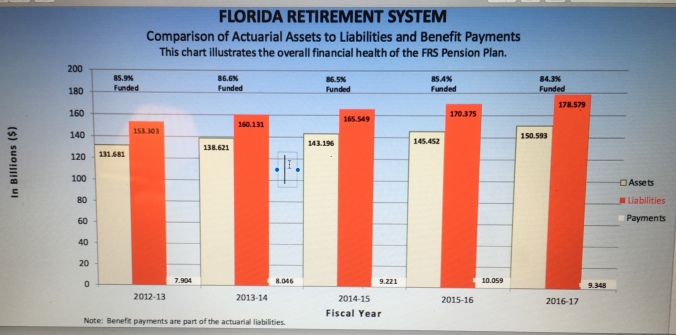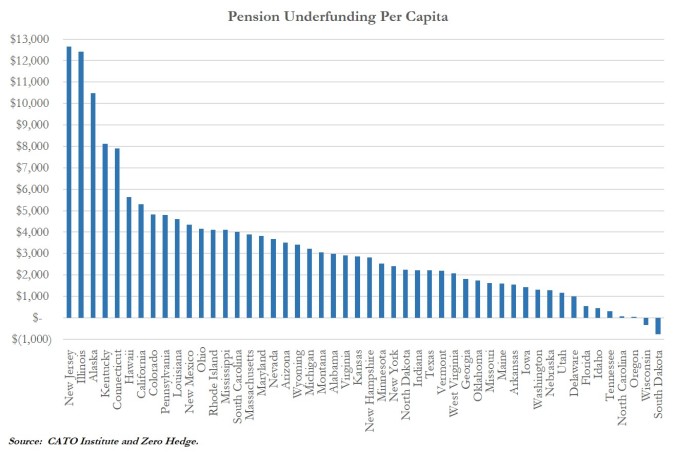
“The biggest (economic, at least) issue we face as a nation is indebtedness.
The way that shows up is in underfunded pension plans.
Firefighters, police and county employees have been promised pension benefits that can’t be paid.
I’ve never seen anyone address the issue on our local/IRC level.”
This was sent to us by reader, which we felt worthy of investigation.
Suzanne Boyll, Human Resources Director for Indian River County (IRC) has been very helpful in promptly answering our questions or pointing us to on-line resources.
To begin with, Indian River County pension programs are provided by the Florida Retirement System (FRS), a $144 billion pension fund; the fourth largest pension plan in the country.
But as of 7/1/17, according to a State of Florida website, the FRS has a plan funding level of 84%. This means that if you were at 100% you could pay employee pension benefits as promised. It is the difference between the total amount due to retirees and the actual amount of money FRS has on hand to make those payments.
Which speaks to our reader’s concern that: “Firefighters, police and county employees have been promised pension benefits that can’t be paid.”
In years when the pension plan is determined to be less than 100% actuarially funded, the Florida Legislature can take steps to improve the funding level.
They can, at any time, increase employee or employer contributions or lower plan costs by reducing Pension Plan benefits. They can also adjust employee and IRC contributions.
But don’t be too disheartened. According to nj.com, from 2014 to 2015, New Jersey’s pension debt rose from $113.1 billion to $135.7 billion.
The Garden State held enough assets to cover just 37.5 percent of its liabilities in 2015, enough to earn the title of worst-funded in the U.S.
Here is a state-by-state chart of pension underfunding. Note that Florida is a star by comparison to the other states, It is the sixth best state in terms of underfunding.

Contributions & Plans:
Each IRC employee can contribute up to 3% into the FRS system. The IRC also contributes to the employee’s accounts as regulated by the state based on the classification of a worker.
Regular Class: 7.92%
Special Risk: 23.27%
Senior Management Service: 22.71%
County Elected Officials: 45.50%
Fire and police are under special risk and then the next large group is the regular class. Only a few positions are Senior Management Service or elected officials.
The employees have two choices where to direct and how to invest their money. They can put it into an Investment Plan, which as the name implies, the money is invested in stocks, bonds, and other type of financial instruments. There are a variety of investment options available and the plan gives the employees as much or as little control over their investments as they like.
The other plan is called a Defined Benefit Plan, designed for employees who want a guaranteed benefit that is based on a formula. This formula uses their earnings, length of service , and other factors.
Counties are required to fund for the retirement contributions as a part of their annual budget. Contributions are submitted to the FRS each month of the year. Florida Statute chapter 121.061 governs the funding of the pension benefit.
What Have Been the Rates of Return?
The funding of a pension plan as you look out actuarially is based on a rate of return.
We found an article in the Orlando Sentinel written on 1/5/2017 that “independent financial consultants say relying on a projected investment return of 7.65 (for Florida’s FRS) is too optimistic and could put the state and local government on the financial hook for millions of dollars.
State analysts lowered the projected rate of return to 7.6 percent in October, down from 7.65 percent.
But the Department of Management Services’ annual report on the financial status of the pension system notes that Milliman, the state’s actuarial consultant, recommended a 7 percent rate of return, saying that is more in line with the uncertain financial climate.
The 7.6 percent assumed rate is “materially above” the estimates developed by Milliman and Aon Hewitt, a financial consultant to the state Board of Administration, which oversees the pension fund, the report noted.”
Here we insert our reader’s comment: ‘They can say things are fine,’ without admitting that ‘fine’ means earning 7% on assets in the plans. The real question is, ‘How much did the plan earn last year?’ With interest rates at around zero, 7% is a fantasy.”
As reported in the palmbeachpost.com on June 30, 2017:
“Florida’s $155 billion pension fund is on track to show a positive gain for the eighth straight year, as the state’s fiscal year ended on Friday.
Although the final number will not be calculated for some time, State Board of Administration officials said they expected the return to be near a Wednesday estimate showing the fund was up 14.24 percent for the fiscal year.
The anticipated double-digit return for the fund — which pays retirement benefits for state workers, teachers, county employees and university personnel — will be a much stronger showing than last year, when the fund eked out a 0.54 percent positive return.”
